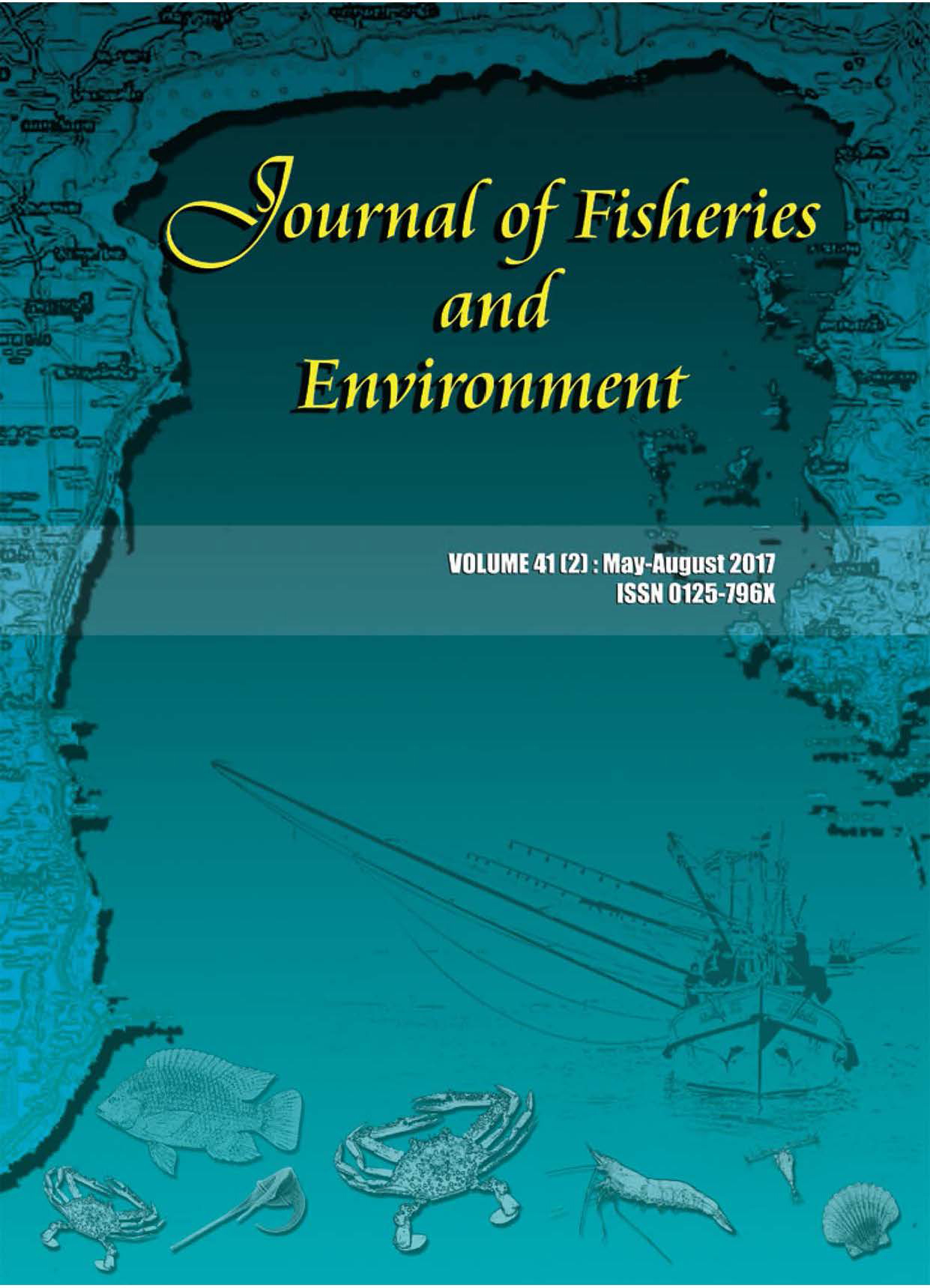Socio-Economics and Cage Culture Practices of Red Tilapia (Tab Tim) at the Taasarn-Bangpla Canal, Nakhon Pathom Province, Thailand
Main Article Content
Abstract
Taasarn-Bangpla is a natural canal in Nakhon Pathom province that has been used to divert water from Mae Klong river to Tha Chin river. The recent increase in fish cage culture raised concerns over its environmental impact. A study on fish cage culture in the canal carried out from 2013-2014 consisted of two interrelated aspects: socioeconomics and environmental. This paper reports the results of the study on socioeconomics which included the number of cages, distribution and production, and culture practices. The survey in 2013 found a total of 35 operators with 527 cages. The cages were mostly concentrated in Tung Kraphanghome sub-district of Kamphaeng Saen district with a small number found in Donthoom district. Red tilapia (Tab Tim) was the cultured species with an approximate production of 1,057 tonnes y-1 from 2 crops per year. Cage culture in the canal first emerged before 2002. The current popularity is a result of private sector promotion through contract farming. Profit margin obtained from successful cage culture has attracted more people to get involved in cage culture. Some farmers practice cage culture as their main occupation while others practiced it as a secondary occupation to earn additional income. The private sector provided technical guidance on how to raise fish, and supplied fingerlings for stocking as well as credit for the essential inputs such as feed and fingerlings. Operators would initially invest in cage construction mainly from their own savings, while other sources come from relatives who provided loans without interest, and/or commercial banks for loans with interest. A floating square metal frame net cage with a size of 5x5x2.5 m3 was the typical cage structure used to stock 30-50 (30-100) g fish-1 at the stocking rate of 25-30 (16-40) fish m-3. Fish was raised for 4-5 (4-7) months with commercial pellet feed containing 0% (25-35%) protein, 3 (2-4) times d-1. Production of 20-28 (10-28) kg m-3 was achieved from 80-90% (50-95%) survival rate of 700-1,000 (400-1,200) g fish-1 at final harvest. FCR ranged between 1.2-1.9 (0.8-3.1). The concern on cage culture at the Taasarn-Bangpla canal is related with its sustainability. Low stocking rates, antibiotic use and aeration were evidences indicating environmental changes in the canal. The absence of strict control measures enabled unlimited proliferation of cages for fish farming, resulting in increased fish production. Thus, there is an issue of how current cage culture practices are affecting sustainability, both the environmental and socioeconomic aspects.
Article Details
References
2. Beveridge, M.C.M., Stewart, J.A. and Petr, T. 1998. Cage Culture: Limitations in Lakes and Reservoirs. FAO Fisheries Technical Paper (FAO), no.374. FAO/DFID Expert Consultation on Inland Fishery Enhancements. Dhaka (Bangladesh), 7-11 Apr 1997.
3. Birthal, P.S., 2008. Making Contract Farming Work in Smallholder Agriculture. https:// www.ncap.res.in/Contract_%20fanning/ Resomces/5.1%20Pratap%20S%20Birthal. pdf (accessed on 12 December 2015)
4. Department of Fisheries. 2013. Fisheries Statistic of Thailand 2010. Department of Fisheries, Ministry of Agriculture and Cooperatives. Bangkok. (in Thai).
5. FAO, 2006. Fisheries policy content and direction in Asian APFIC member countries. Regional Office for Asia and the Pacific Bangkok, 2006RAP PUBLICATION 2006/ 23. pp 18-21.
6. Hiranwat, S. and Tavarutmaneegul, P. 1994. Fish Cage Culture in Thailand. Technical Paper No. 157. National Inland Fisheries Research Institute, Department of Fisheries. 125 p.
7. Hottle, G.K, T. Samphawamana and S. Ingthamjitr. 2011. Tilapia culture in the Lower Mekong Basin. Catch and Culture Volume 17, No. 2, August 2011.
8. Irz, X., James, R. S., Arnold, T., Portia V. and Pierre M. 2007. The Equity and Poverty Impacts of Aquaculture: Insights from the Philippines. Development Policy Review, 2007, 25 (4): 495-516.
9. Jesoh, S., Kaewsrithong, C. and Damchoo, S., (n.d.). Assessment of cage fish culture in Saiburi river. (in Thai). https://www.fisheries.go.th/ if-pattani/web2/images/stories/fishsaiburi.pdf (accessed on 16 October 2015).
10. Lebel, P., N. Whangchai, C. Chitmanat, J. Promya, P. Chaibu, P. Sriyasak, and L. Lebel. 2013. River-based cage aquaculture of Tilapia in northern Thailand: Sustainability of rearing and business practices. Natural Resources 4:410-421.
11. Lin, C.K. and Kaewpaitoon, K. 2000. An overview of freshwater cage culture in Thailand. In Cage Aquaculture in Asia: Proceedings of the First International Symposium on Cage Aquaculture in Asia, Pingtung, Taiwan, November 2-6, 1999, 253-257.
12. Phimphakan, L., N. Whangchai, C. Chitmanat, J. Promya and L. Lebel. 2014. Access to Fish Cage Aquaculture in the Ping River, Northern Thailand. Journal of Applied Aquaculture. 26:1, 32-48, DOI: 10.1080/10454438.2014.877731.
13. Prowse, M. Making contract farming work with cooperatives. https://www.researchgate.net/publication/238798354_'Making_Contract_Farming_ Work_with_Cooperatives' (accessed on 29 December 2015).
14. Thai Water Partnership. 2013. National Consultation Report on water in the post-2015 development Agenda. Global Water Partnership Southeast Asia. 8 p.

